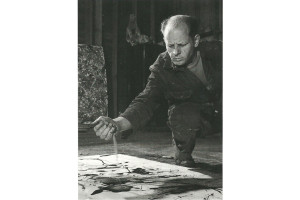
Jackson Pollock’s Obsession with Native American Art
A featured article in the World of Interiors discusses the foundational influence of Native American Art on Jackson Pollock, now on view at Frieze Masters, London
ca. 1860–1880
wood, metal, mirror, cord, red, black and blue/green pigments
width: 28 ½"
Inventory # N3578
Sold
acquired by The Audain Art Museum, Whistler, BC
Donald Ellis Gallery catalogue, 2010, pgs. 4-5
Wardwell, Allen. Objects of Bright Pride: Northwest Coast Indian Art From the American Museum of Natural History. Seattle: University of Washington Press, 1978, pg. 69, pl. 37
Articulated masks are one of the great accomplishments of Northwest Coast artists. The movement of articulation can bring an otherwise static image to life in the firelight of a traditional performance house. This large mask contains two moving features: The lower mandible opens and closes at the pull of a cord, and the red disk representing the sun can be made to move forward and back within the beak. The overall image illustrates the well-known Northwest Coast story of Raven bringing daylight to the world. Coupled with the shrouding of a simple blanket or feathered raven costume, the movements of this mask and its manipulation by a skilled dancer would create a truly remarkable performance. The best dancers studied the actions and characteristics of the animals they imitated, and one can truly be astounded by the sounds and movements of a huge raven or other creature as it moves through the firelight and shadows to the accompaniment of drumming and singing.
The range of colors and characteristics of this mask indicate an origin to the north of Vancouver Island in the territory of the Nuxalk or Heiltsuk peoples of the central Northwest Coast. Several features of the mask indicate this region as the source of the carving: the profile shape and cross section of the upper beak, the form of the red nostrils, the shade of blue-green mineral-pigment in the eye sockets, and the use of a metallic washer-like form as the iris of the eye, which is pierced at the center to expose a piece of glass mirror in the pupil. In addition, the hinge of the lower mandible is a wooden peg that pierces the cheek area; this is a much more common style of hinge among these central coast groups than among the Kwakwaka’wakw, who most often employed a leather hinge nailed across the joint of the lower beak. A sculptural characteristic that is often seen in Heiltsuk and Nuxalk forehead masks and seldom if ever among other groups is the way the eyebrows here lie almost flat on the forehead of the bird, with a strong undercut on their undersides at the top of the eye sockets. This interesting sculptural feature, in concert with the strong profile of the upper beak, creates a naturalistic appearance in an otherwise stylized form of the raven’s head. This mask is most likely Nuxalk in origin, though it also shares some characteristics with masks that can be traced to the Heiltsuk. Certain villages in the Nuxalk area existed in an overlap with Heiltsuk territory, and contained a population of both tribes/language groups. Kimsquit village at the end of Dean Channel and Kwatna village in Kwatna Inlet were two locations that sheltered both Nuxalk and Heiltsuk populations. It is probable that a good deal of artistic and cultural exchange took place in these areas, and artworks developed with the design characteristics of both peoples.
The sculpture and finish of the surfaces on this mask are superb, indicating the hand of a practiced and knowledgeable artist. The use of glass mirror in the eyes is a feature often seen in Nuxalk sculptures, from masks to headdress frontlets. The mirror is calculated to catch and reflect the firelight as the dancer moves his head, the viewer seeing a bright flash of light in the eye. Movable jaws are a fairly common form of articulation, but the sliding sun image seen here appears to be unique to this mask. The overall visual impression of this large, beautifully carved and imaginatively articulated mask must surely have been astonishing.
Steven C. Brown, November 2009

A featured article in the World of Interiors discusses the foundational influence of Native American Art on Jackson Pollock, now on view at Frieze Masters, London

Donald Ellis consulted the Vancouver Art Gallery and lent a number of artworks to the extraordinary exhibition The Colour of My Dreams: The Surrealist Revolution in Art

$35.00 USD